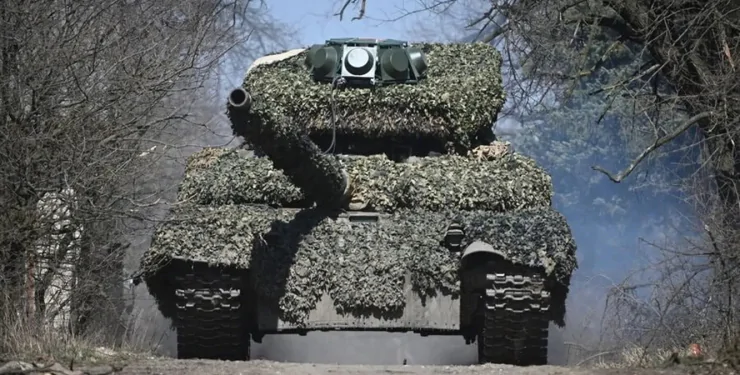A Russian T-72 tank was dubbed the “turtle” as it was covered on all sides with metal sheets. These tanks also have small electronic warfare systems attached to them.
On their Telegram channel, the Ukranian operational-strategic group of troops, “Khortytsia,” published video footage of an enemy attack. In particular, the Ukrainian military video captured a tank with a new type of anti-drone defense.
A metal visor covered the Russian T-72 tank’s top and side projections. However, the video does not indicate whether the tank had additional protection in the form of a net or something similar in the front and rear.
Judging from the image, the main task of this structure is protection, primarily against FPV strikes. Such a visor can also protect against UAVs dropping ammunition onto the equipment.
Later, the Russians published a video showing how they prepared this tank for the assault. The T-72 received a trapezoidal steel structure, which increased its width and height. They also equipped this tank with a knife-type mine flail.
According to the video, the Russian T-72, with a steel visor, managed to retreat to Russian positions. It is unknown whether this tank suffered any damage.
So far, it has been an experiment on the ground rather than a widespread phenomenon. The additional protection in the field is sometimes called “mangals.” The drone detonates and explodes upon contact with this metal barrier at a certain distance from the tank, the tank armor, and the devices on the tank. Thus, the tank easily withstands the explosive impact, reducing damage.
For the first time, continuous protection is provided on the sides and above the tank. These are retractable, lightweight sheets with spaces between them that appear to be hinged. Thanks to this design, the tank appears to be fully protected from all sides. However, the degree of this protection is unclear because qualified professionals also control FPV drones, and an FPV drone can easily fly into sections of the tank’s nose or stern that these steel sheets do not cover.
The Turtle tank experiment seems to be a coherent progression from the anti-drone visors, colloquially referred to as “coop enclosures,” that were first observed during this conflict.
Russian Tanks Now Built-in EW Drone Defense
According to a recent Russian arms production newsletter, the T-90M and T-72B3 tanks have started serially receiving a comprehensive electronic warfare station that is supposed to operate 360 degrees.
“The new spectrum of production tasks is related to implementing innovations in combat vehicle technical equipment. Installation of a complex of means to reduce visibility is underway. Armored products are equipped with electronic warfare, which means they can counter unmanned aerial vehicles,” writes the publication dedicated to fulfilling the state defense order.
Today, various types of UAVs significantly threaten armored vehicles in special operations, including the most heavily armored ones, such as tanks. FPV drones carrying cumulative warheads are widely used and capable of striking vehicles in vulnerable spots. Earlier, videos were published on official channels and made publicly available, showing tanks equipped with EW (electronic warfare) equipment to counter drones, allowing them to repel their attacks effectively.
The new EW system consists of eight cylindrical antennas to protect against FPV drones. Two types of tanks, the T-72B3 and the T-90M “Breakthrough,” now sport these antennas.

The Russians are attempting to create a protective dome that should make it impossible for drones to strike the tank as kamikaze drones. Some sources claim that the new EW system detects drones at up to 1500 meters and should jam them at distances of up to 1000 meters. Its design allows it to jam drones at 800-1200 watts.
“Uralvagonzavod” supplies the Russian Armed Forces with modern tanks such as the T-90M “Breakthrough,” upgraded T-80BVM, T-72B3, and T-72B3M. These new domestic tanks, enhanced based on operational experience in combat conditions, come equipped with EW and stealth reduction mechanisms, all-around dynamic protection, and anti-drone “visors” above the turret.
Strengthening vulnerable areas of the T-72B3 with dynamic protection
Russian tank crews have increased the protection of the T-72B3 tank by eliminating the vulnerable area near the driver’s hatch, reports the Telegram channel “In the Light of Events.” The channel specified that the tank had been equipped with additional dynamic protection in this manner.
During field modernization, the T-72B3 received a visor with six protective blocks above the hatch. The retractable design ensures that the innovation does not hinder the driver’s ability to occupy or exit their position. This upgrade will protect the vehicles’ upper hemisphere from FPV drones and grenades dropping into open hatches.
